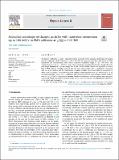Azimuthal anisotropy of charged particles with transverse momentum up to 100 GeV/c in PbPb collisions at √SNN = 5.02TeV
Author(s)
Abercrombie, Daniel Robert; Allen, Brandon Leigh; Apyan, Aram; Azzolini, Virginia; Barbieri, Richard Alexander; Baty, Austin Alan; Bi, Ran; Bierwagen, Katharina; Brandt, Stephanie Akemi; Busza, Wit; Cali, Ivan Amos; D'Alfonso, Mariarosaria; Demiragli, Zeynep; Gomez-Ceballos, Guillelmo; Goncharov, Maxim; Hsu, Dylan George; Iiyama, Yutaro; Innocenti, Gian Michele; Klute, Markus; Kovalskyi, Dmytro; Krajczar, Krisztian F.; Lai, Yue Shi; Lee, Yen-Jie; Levin, Andrew Michael; Luckey Jr, P David; Maier, Benedikt; Marini, Andrea Carlo; McGinn, Christopher Francis; Mironov, Camelia Maria; Narayanan, Siddharth Madhavan; Niu, Xinmei; Paus, Christoph M. E.; Roland, Christof E; Roland, Gunther M; Salfeld-Nebgen, Jakob Maxillian Henry; Stephans, George S. F.; Tatar, Kaya; Velicanu, Dragos Alexandru; Wang, J.; Wang, Ta-Wei; Wyslouch, Boleslaw; ... Show more Show less
Download1-s2.0-S0370269317309334-main.pdf (934.7Kb)
PUBLISHER_CC
Publisher with Creative Commons License
Creative Commons Attribution
Terms of use
Metadata
Show full item recordAbstract
The Fourier coefficients v[subscript 2] and v[subscript 3] characterizing the anisotropy of the azimuthal distribution of charged particles produced in PbPb collisions at √sNN =5.02 TeV are measured with data collected by the CMS experiment. The measurements cover a broad transverse momentum range, 1 < p[subscript T] < 100 GeV/c. The analysis focuses on the p[subscript T] > 10 GeV/c range, where anisotropic azimuthal distributions should reflect the path-length dependence of parton energy loss in the created medium. Results are presented in several bins of PbPb collision centrality, spanning the 60% most central events. The v[subscript 2] coefficient is measured with the scalar product and the multiparticle cumulant methods, which have different sensitivities to initial-state fluctuations. The values from both methods remain positive up to p[subscript T] ∼60–80 GeV/c, in all examined centrality classes. The v[subscript 3] coefficient, only measured with the scalar product method, tends to zero for p[subscript T] ≳20 GeV/c. Comparisons between theoretical calculations and data provide new constraints on the path-length dependence of parton energy loss in heavy ion collisions and highlight the importance of the initial-state fluctuations. Keywords: CMS, QGP, High-pT, Flow, Parton energy loss,
Jet quenching
Date issued
2017-11Department
Massachusetts Institute of Technology. Department of Physics; Massachusetts Institute of Technology. Laboratory for Nuclear ScienceJournal
Physics Letters B
Publisher
Elsevier BV
Citation
Sirunyan, A. M., et al. “Azimuthal Anisotropy of Charged Particles with Transverse Momentum up to 100 GeV/ c in PbPb Collisions at √sNN = 5.02 TeV.” Physics Letters B, vol. 776, Jan. 2018, pp. 195–216. © 2017 The Authors
Version: Final published version
ISSN
0370-2693